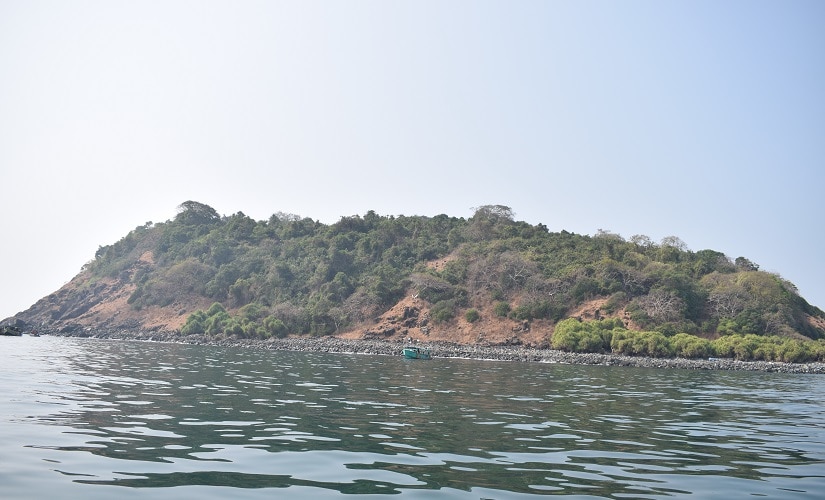SOURCE: FIRST POST

Local fishermen and environmentalists got a rude shock on Tuesday, 27 March, when naval warships resumed shelling the ecologically sensitive Netrani Island off the Bhatkal coast of Karnataka. In September 2012, the Indian Navy had promised the Karnataka High Court that they would suspend target practice on the scenic island and, for the past five years, had kept their word.
But the Indian Navy is dogged, and the resumption of target practice suggests that they have secured clearance from the government. “They have gone for an out-of-court settlement with the Karnataka government, which a number of politicians of Uttara Kannada and top officials have helped broker,” says Dr VN Nayak, former director of the Uttara Kannada science centre.
“I do not know how valid it is and, in a proverbial bolt from the blue, one of the judges has ruled that national security is more important than protecting the environment of a small island. It was a one-line judgment,” he adds.
Confirms, SS Nakul, deputy commissioner of Uttara Kannada, “All precautions have been taken to ensure trouble-free target practice of the Indian Navy in the area, as the navy has all the clearances to this effect.”
Netrani Island had been used as a firing range for over a decade when, in April 2011, Karnataka’s former additional director general of police (forests), KSN Chikkerur had visited the island with experts from the local science centre, forest officials and ecological scientists.
He recorded extensive damage to the island’s vegetation due to shelling and found it littered with shells and explosive residues. Chikkerur wrote to the head of the Indian Navy’s Western Command, seeking his help to stop the wanton destruction of the island.
In 2012, environmental activists petitioned the Karnataka High Court to restrain the navy from bombing Netrani Island. That September, the navy appeared before a two-judge bench, comprising Justices Vikramjit Sen and Nagarathna, and gave the court an undertaking not to use Netrani for gunnery and target practice thereafter.
Netrani island is the last remaining island of the Western Ghats archipelago, the rest of the chain having long been submerged. It’s situated 12.5 nautical miles (19 kilometres) from the mainland. The Karnataka Biodiversity Board has since declared the island a biodiversity-heritage site.
At the direction of the court, the district administration mapped the area and determined that Netrani Island fell within the jurisdiction of the Bhatkal taluk panchayat. The panchayat lost no time in claiming it legally and sought to establish its jurisdiction over all activities related to the island, including scuba-diving expeditions.
After the high court intervention, the navy launched a massive clean-up of the island, which was widely appreciated. As a former president of the Bhatkal taluk panchayat said, “It is our navy and they are our protectors, we cannot just ask them to go away. Instead, the government and the high court should have given them an alternative area for their gunnery practice”.
Several Karnataka forest officials have stood up against the destruction of Netrani Island. “It is the last of the Western Ghats archipelago islands that survived along with some of the wildlife mentioned in the Schedule I of the Wildlife Act, including the white-breasted eagle, edible-nest swiftlets, corals and few of endangered varieties of sharks. All these were under the protection of the Biodiversity Board,” says an official, who had helped prepare some of the reports that were submitted to the court.
As Chikkerur, whose visit to Netrani brought the issue to a head, remembers, “I had found at least three creatures that demand Schedule I-type protection in the Wild Life Protection Act, 1972. The white-breasted eagle, Olive Ridley sea turtles, a number of corals and sea cucumbers which had been damaged along with sensitive wildlife on both the island and the peripheral waters.”
Nayak told this correspondent that Netrani island also has many other features like water-level openings that lead into the interior of the island, where different varieties of sharks shelter to deliver their young. “But the interior walls of the openings are degenerating and if the shelling continues, I am afraid the walls to the opening may collapse.”
Other marine life in the seas around Netrani Island include nine grouper fish species, the endangered Cheilinus undulates (hump head wrasse) and Rhincodon typus (the whale shark). “The island boasts of two types of coral reefs, seven seaweed species, 12 jellyfish species, six sponge species, 92 finfish species, 17 crab species, four lobster species and three sea-snake species, among others,” says Nayak.
“Elsewhere along the same coast, a rare octopus species, a rare lingula species, a species of hermit crab, five species of starfish, two species of sea urchins, one species of sea cucumber, a sunfish species (called mola mola), three species of endangered sea turtles, three species of sea snakes, three species of dolphins and four species of whales have been found,” he adds.
This stretch of coast is also known for the dolphin-sighting tours operated by local fishermen. It sees a steady flow of foreign tourists who come for the snorkelling and scuba diving as the coral reef around the island is exquisite. But tour operators say they have no problem with the navy’s live-ammunition practice.
A forest official says that, in any case, the navy has asked permission to use only a small portion of the island for target practice. “They have even promised to clean up the debris after every target-practice session,” he says reassuringly.
from Indian Defence Research Wing https://ift.tt/2J6mfAe
via IFTTThttp://idrw.org
No comments:
Post a Comment